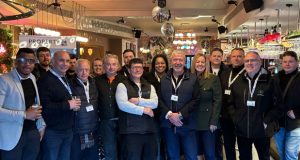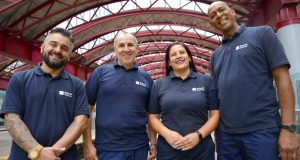Worktech 19 London, which took place on November 27-28, included insights into the sentient workplace, the super experience, different scenarios for the future of work and why we all need to slow down
The global series of Worktech conferences is produced by the Worktech research platform that looks into all aspects of workplace intelligence. Some of the content could be viewed as containing a little too much blue sky thinking for the typical FM, who is generally more concerned with the day-to-day challenges of facilities management than the future of work and the workplace. However, as FMs are increasingly charged with using digital tech to improve their users’ experience, they would have found that some of the key themes at this year’s London event were particularly relevant – not least how the sentient workplace can help drive smart decisions and benefit employers by attracting and retaining talent.
Sentience and super experiences
As Philip Ross, futurologist and CEO of Cordless Group and UnWork, explained in his presentation on the sentient workplace, this means finding ways of creating a space where people feel engaged and a sense of belonging. He added it was difficult to predict what people want without using digitally collected data, which is why the ideal solution is to fuse digital tech to the physical space.
Matthew Taylor, chief executive at the RSA, recapped the charity’s Future Work Centre model of four different scenarios for the future of work in 2035: the big tech economy, the precision economy, the exodus economy and the empathy economy. But, he warned, we need to avoid asking the ‘ridiculous’ question ‘how do we adapt to technology’? The question should be how can technology adapt and develop in order to meet human needs?
In a particularly lively session, Jeremy Myerson, director at Worktech Academy and a research professor for the Royal College of Art, teamed up with Adam Scott, founder of the global experience masterplanning agency, FreeState, to explore the concept of the Super Experience. By taking a people-first approach, they explained, you can ‘curate experiences’ within a workplace, from increasing the chances of serendipitous encounters to improving users’ immersion in the space.
Nelly Ben Hayoun of Studios One, sometimes known as the ‘director of experiences’, had much to say about the topic in a frenetic presentation which left listeners baffled but strangely inspired. One kernel of insight gleaned from her session was the need to view an office space as more of a series of organised communities than a workplace.
As is typical of this sort of event, to see and hear the good stuff you had to sit through the more commercial sessions, such as Harald Becker, director of industry engagement and research at Microsoft, talking about how the software giant’s vision is centred on “bringing together groups of inspired people from around the world to connect with each other [using Microsoft tools] to further the knowledge around tomorrow’s big challenges”.
User behaviours
The second day kicked off with Jennifer Celesia of Haworth filling the keynote slot originally intended for Bruce Daisley of Twitter. She picked up on one of the major themes of day one: the super experience, with reference to the need to understand behaviours. If we know how people behave in a space, how they use it and what they want from it, then we can give them a better space to reflect their needs.
She also suggested the lessons that commercial office space designers and managers can learn from retail and other sectors. Retailers are using ideas such as augmented mirrors to maximise the use of space and blend the data with actual user experiences, while the master of user experience – the hospitality sector – constantly seeks feedback in constructive and subtle ways to help improve their offer and the guest experience.
The examples Celesia cited were reminiscent of what Deloitte (one of the case study examples on day one) had done at New Street Square, reinforced in presentations from Siemens and Barings Bank, Royal Bank of Scotland and PwC. Each had begun with the need to use their available space more efficiently, with design and the use of technology critical to the successful transition to their new-look workplaces.
One of the highlights of the event was Jeremy Myerson’s interview with architect Sir David Adjaye, who strongly believes in making space for reflection. His work is focused on the concept of creating meaning, memory and learning, and he wants the spaces he creates to have a vision and shape. But fundamental to that is a sense of community and the ability to find a reflective space within whatever he creates.
Jeremy Myerson’s second interview with Ollie Olsen, cofounder and CEO of The Office Group (TOG), was a fascinating look into the success of TOG and its evolving philosophy. It included some startling insights, such as that TOG does not measure the performance of its buildings or space, with no use of technology to analyse performance or monitor feedback. Instead he physically talks to customers, making a point of using TOG spaces and working alongside people. In this way he experiences for himself if a space is functioning as it should, asking people what they like or not. As a result, TOG is expanding with around 38 buildings open in the UK and another 30 or so in development, with ideas to expand in Germany and further afield across Europe.
Olsen’s main premise is that coworking and therefore workplace generally is driven by what employees want. If their corporate space isn’t good enough, they will work in coworking space. Hence, we need to trust them. That was wrapped up in Leeson Medhurst’s explanation of the report and research that his team at 360 Workplace had done alongside The United Workplace and Worktech Academy into the effects of leadership and leadership style. His conclusion agreed with Olsen – we need to trust the employees. He argued that despite the research indicating that leadership is the single most important factor in driving workplace productivity, designers don’t make that connection.
Commercial time
The conference had its fair share of commercial case studies, which included highlights such as the money vault turned into funky non-bank space by Rocket Space and LOM architects on behalf of RBS. Equally notable were the definitely innovative application of technology by Siemens and Barings, and PwC’s ‘connected digital front office’ concept.
While the panel discussion led by Philip Ross between Peter Otto of Condeco and Neil Riddell of Macquarie Bank essentially covered the same ‘tech innovation is a good thing’ theme, Riddell did make the brilliant point that you can have too much data. You only need to measure certain stuff, otherwise you are measuring for the sake of it. Slightly alarmingly he pointed out that with the rise of sensors in buildings, it’s inevitable that video cameras will be everywhere too.
Which brought us to the closing 20-minute session that could easily have been a whole day and deserved to be heard by a bigger audience: Richard Watson, futurologist from Imperial College, talking about slowing down.
He said that despite the reduction in working hours, 40 hours now, on average, compared to around 70 hours in the 19th century, we are far too busy and never switch off. We need to do less and achieve more. We need to slow down, physically and metaphorically. He argued that actual walking speeds have increased, not just our pace of work. We use our time poorly, and despite time-saving ideas like self-service checkouts, we are instead gorging on Google, preoccupied by IT and end up insulating ourselves against social interactions by claiming we are too busy because of emails, social media and a sense of FOMO if we switch off.
Watson argued strongly that concepts like procrastination, staring out of the window and thinking and so on are not a waste of time but are actually good reflective processes where we find our best ideas. He didn’t make the overt connection back to David Adjaye, but it was the same argument. Instead of assuming the ‘busy’ person racing around the office going to and from meetings is the most productive, why not consider the person thinking over a problem while staring into space?




